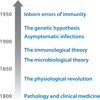The genetic theory of infectious diseases: a brief history and selected illustrations
- PMID: 23724903
- PMCID: PMC4980761
- DOI: 10.1146/annurev-genom-091212-153448
The genetic theory of infectious diseases: a brief history and selected illustrations
Abstract
Until the mid-nineteenth century, life expectancy at birth averaged 20 years worldwide, owing mostly to childhood fevers. The germ theory of diseases then gradually overcame the belief that diseases were intrinsic. However, around the turn of the twentieth century, asymptomatic infection was discovered to be much more common than clinical disease. Paradoxically, this observation barely challenged the newly developed notion that infectious diseases were fundamentally extrinsic. Moreover, interindividual variability in the course of infection was typically explained by the emerging immunological (or somatic) theory of infectious diseases, best illustrated by the impact of vaccination. This powerful explanation is, however, best applicable to reactivation and secondary infections, particularly in adults; it can less easily account for interindividual variability in the course of primary infection during childhood. Population and clinical geneticists soon proposed a complementary hypothesis, a germline genetic theory of infectious diseases. Over the past century, this idea has gained some support, particularly among clinicians and geneticists, but has also encountered resistance, particularly among microbiologists and immunologists. We present here the genetic theory of infectious diseases and briefly discuss its history and the challenges encountered during its emergence in the context of the apparently competing but actually complementary microbiological and immunological theories. We also illustrate its recent achievements by highlighting inborn errors of immunity underlying eight life-threatening infectious diseases of children and young adults. Finally, we consider the far-reaching biological and clinical implications of the ongoing human genetic dissection of severe infectious diseases.
Figures






References
-
- Abel L, Plancoulaine S, Jouanguy E, Zhang SY, Mahfoufi N, et al. Age-dependent Mendelian predisposition to herpes simplex virus type 1 encephalitis in childhood. J. Pediatr. 2010;157:623–629. - PubMed
-
- Alcaïs A, Abel L, Casanova JL. Human genetics of infectious diseases. In: Speicher MR, Antonarakis SE, Motulsky AG, editors. Vogel and Motulsky’s Human Genetics: Problems and Approaches. 4th. Berlin: Springer-Verlag; 2010. pp. 403–415.
-
- Alcaïs A, Alter A, Antoni G, Orlova M, Van Thuc N, et al. Stepwise replication identifies a low-producing lymphotoxin-α allele as a major risk factor for early-onset leprosy. Nat. Genet. 2007;39:517–522. - PubMed
-
- Alcaïs A, Quintana-Murci L, Thaler DS, Schurr E, Abel L, Casanova JL. Life-threatening infectious diseases of childhood: single-gene inborn errors of immunity? Ann. N. Y. Acad. Sci. 2010;1214:18–33. - PubMed
Publication types
MeSH terms
Grants and funding
- U01 AI088685/AI/NIAID NIH HHS/United States
- HHMI/Howard Hughes Medical Institute/United States
- R37 AI095983/AI/NIAID NIH HHS/United States
- 8UL1TR000043/TR/NCATS NIH HHS/United States
- R01 AI089970/AI/NIAID NIH HHS/United States
- 5R01AI088364/AI/NIAID NIH HHS/United States
- 5R01NS072381/NS/NINDS NIH HHS/United States
- 5P01AI061093/AI/NIAID NIH HHS/United States
- UL1 TR000043/TR/NCATS NIH HHS/United States
- 5R01AI089970/AI/NIAID NIH HHS/United States
- R01 NS072381/NS/NINDS NIH HHS/United States
- 268777/ERC_/European Research Council/International
- 5U01AI088685/AI/NIAID NIH HHS/United States
- 5R37AI095983/AI/NIAID NIH HHS/United States
- R01 AI088364/AI/NIAID NIH HHS/United States
- P01 AI061093/AI/NIAID NIH HHS/United States
LinkOut - more resources
Full Text Sources
Other Literature Sources
Medical
Miscellaneous

